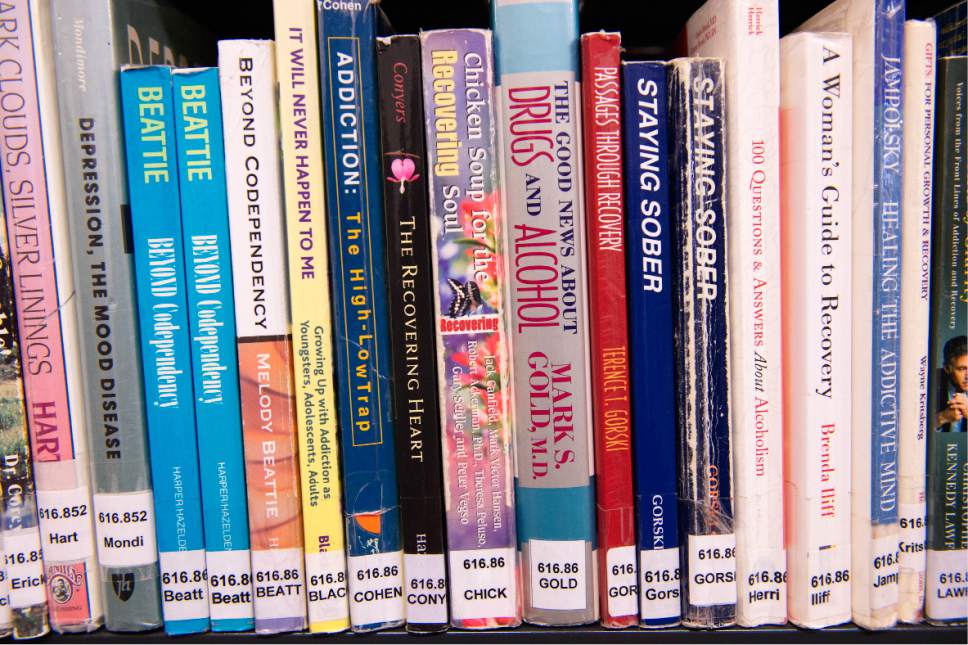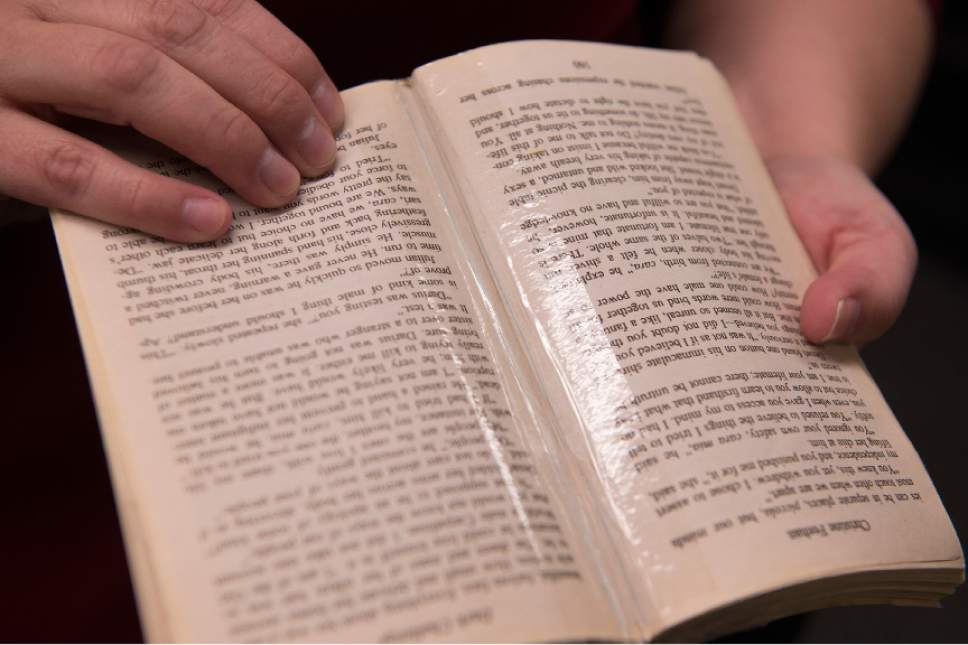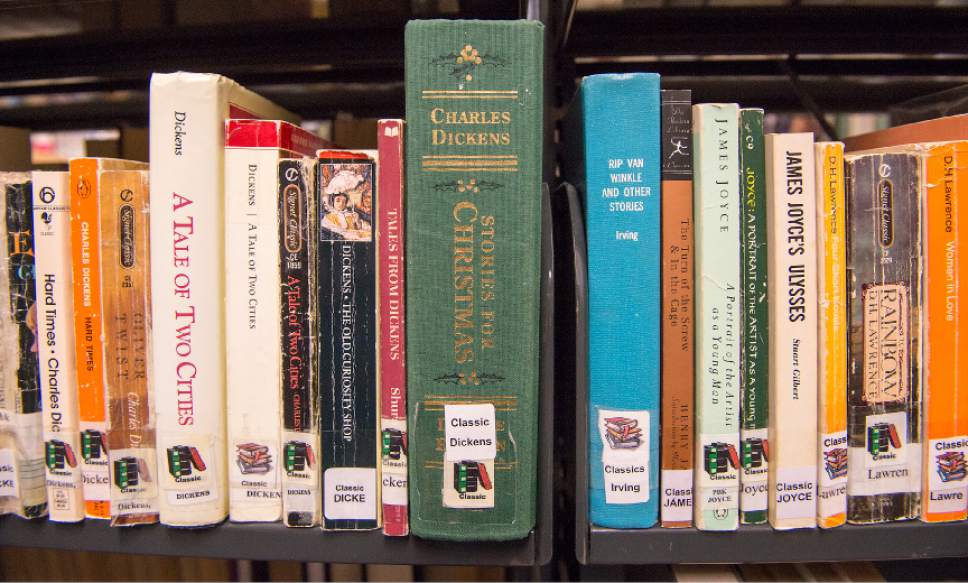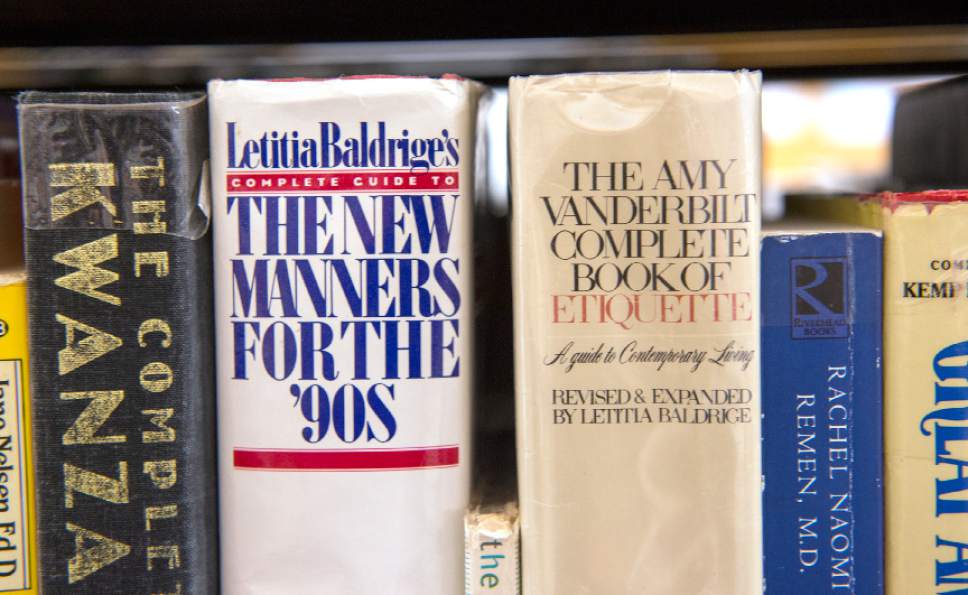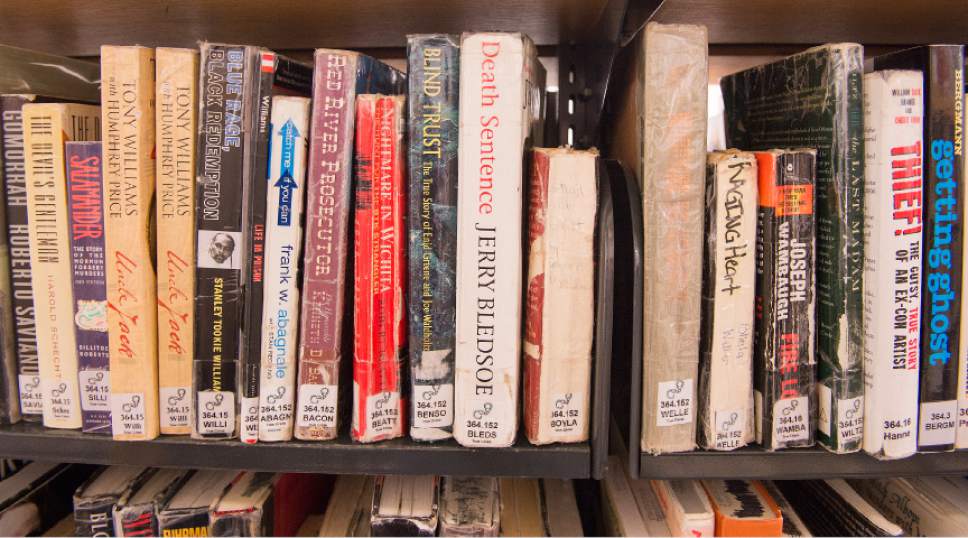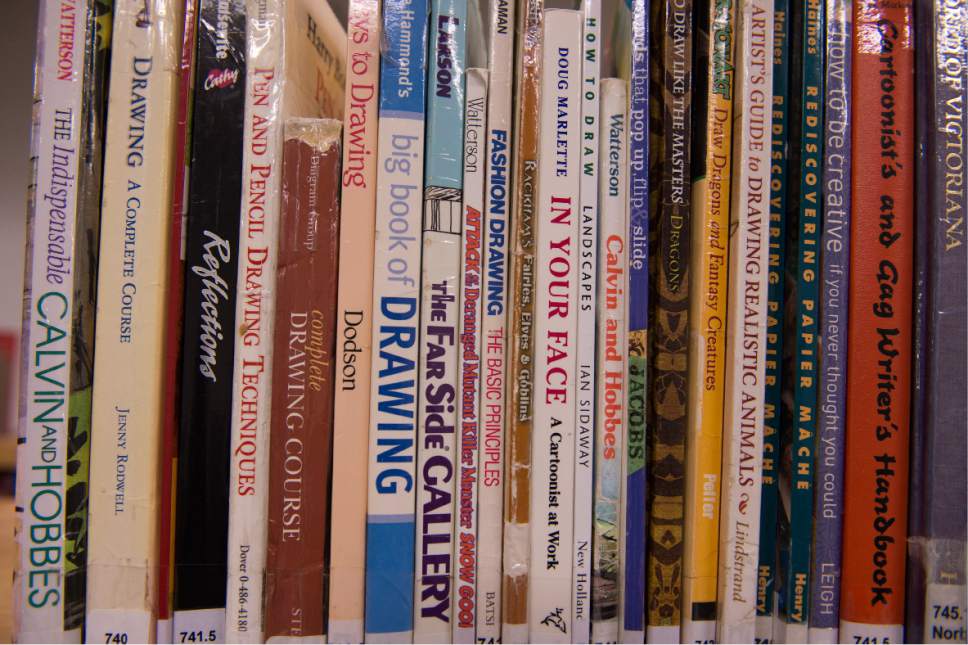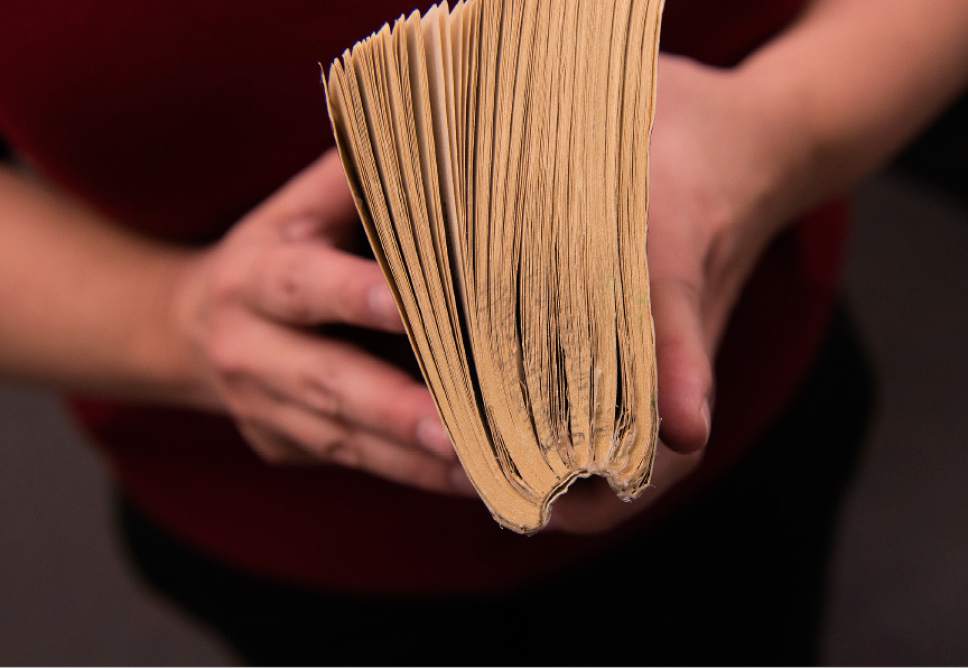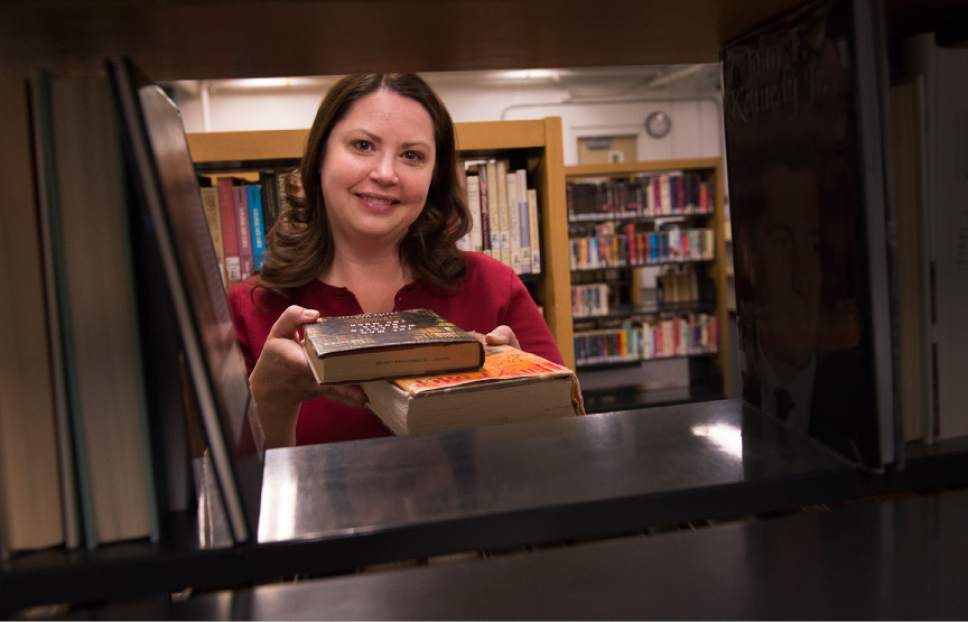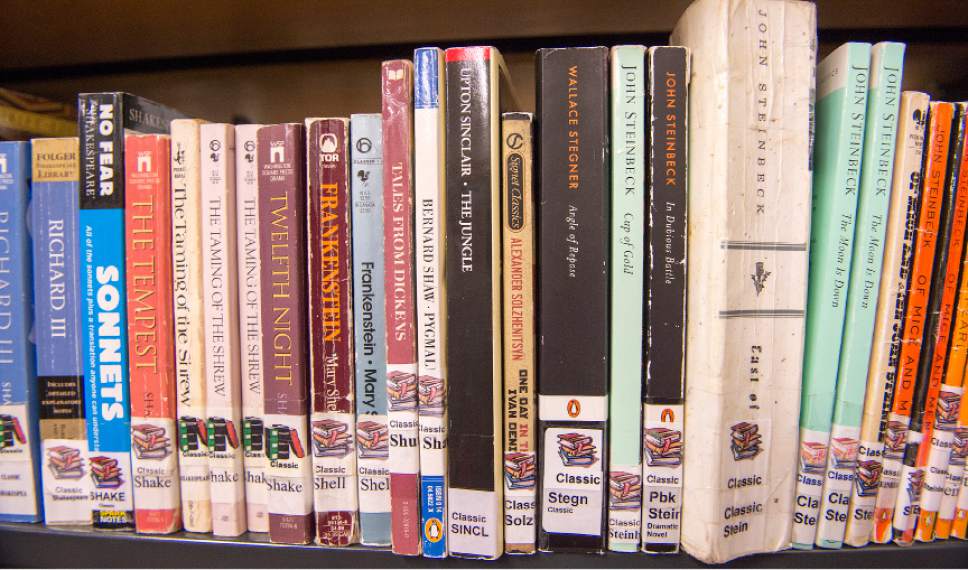This is an archived article that was published on sltrib.com in 2017, and information in the article may be outdated. It is provided only for personal research purposes and may not be reprinted.
For the inmates locked up at the Utah State Prison, copies of John Grisham's "A Time to Kill," the classic "Crime and Punishment" and each installment in the "Game of Thrones" series are permitted — even encouraged — reading.
But two provocative guidebooks are not.
As the only titles on the prison's banned books list, "The 48 Laws of Power" and "The Art of Seduction," both by Robert Greene, are not allowed inside the institution's towering wire fences. The reason? They're all about manipulation.
A matter of security • Christie Jensen, the prison's librarian for more than a decade, sits at the checkout desk. There aren't any inmates browsing through the books, so she stares out at the small, unadorned room filled with 5-foot-tall shelves.
She can't remember exactly when the two books were banned by the prison — probably four or five years ago — and it's unclear to her who made the call. The decision, she said, was passed down by some official of "the institution," not the library. (Lists obtained by The Salt Lake Tribune also do not show an enforcement date or acting employee's name.)
Prison spokeswoman Maria Peterson said those details were lost in the shuffle when a new executive director started shortly after the ban was instituted; other leaders also retired and were replaced about the same time.
"All of the people who were here, are no longer," she said.
The ban was categorized as a security measure, accompanied by a brief explanation. Prison officials feared the books, Jensen said, could show inmates "how to control people, how to get people to do exactly what you want them to do."
Knowledge is power • Law 15: Crush your enemy totally. Law 17: Keep others in suspended terror. Law 33: Discover each man's thumbscrew.
These are a few of the guidelines that make up Greene's first book, "The 48 Laws of Power," published in 1998. It's been described as the "bible for atheists," "chicken soup for the soulless" and, by The New Yorker, a manual on "how to be a creep."
Nevertheless, the title is categorized as a self-help and psychological guidebook, selling more than 1.2 million copies nationwide.
"I went to an extreme for literary purposes because I felt all the self-help books out there were so gooey and Pollyanna-ish and nauseating," Greene said in a 2012 interview with The Guardian.
Attempts by The Tribune to interview Greene were unsuccessful.
In the introduction to "The 48 Laws of Power," after noting the book's instructions can "make people bend to your will without their realizing what you have done," Greene offers a warning. "It might be better to turn back," he writes. "Power is endlessly seductive and deceptive in its own way."
Techniques for control • Greene's second book, "The Art of Seduction," is not necessarily any more benign. The 2001 best-seller focuses on "weapons of persuasion and charm" used to woo often unwilling subjects.
"[These strategies] will instruct you on how to create a spell, break down people's resistance, give movement and force to your seduction, and induce surrender in your target," Greene writes. Instructions include "choose the right victim" and "use the demonic power of words to sow confusion."
Based on historical references to Sigmund Freud, Sun Tzu and Niccolo Machiavelli, the laws are intended as examples of techniques for control that have worked for generations. Though Greene says he doesn't try to follow all of his own advice.
"Anybody who did would be a horrible ugly person to be around," he told The Telegraph in 2012.
Both "The 48 Laws of Power" and "The Art of Seduction" had been in circulation for at least 10 years before they were banned at the Utah State Prison — and it's unclear what event, if any, caused the works to be put on the banned-books list, Peterson, the prison spokeswoman, said.
Additionally, Greene has two other similar self-help books, "Mastery" and "The 33 Strategies of War." Neither is expressly prohibited at the state prison, though the library does not own any copies.
Inmates haven't shown much interest in "The 48 Laws of Power" or "The Art of Seduction." Jensen said they either know the books are banned and don't bother to ask for them or have never heard of the works. A few, about seven in her 11-year career at the prison, have asked about Greene's titles, but she says no one balked when told the books were not allowed.
Is the ban unreasonable? • For the state prison to have just two titles on its banned books list is, in some ways, atypical. Plenty of prisons in other states are far more prohibitive.
The Texas Department of Criminal Justice, for instance, has a list of more than 15,000 banned titles, including a biography about Oprah Winfrey and a collection of Shakespeare's love sonnets, according to a report from the Texas Civil Rights Project. North Carolina prisons prohibit "How to Draw and Paint Birds" and a book about The Beatles in its list of nearly 600 works.
What's odd about Utah's list, then, isn't so much the number of books or the selected titles but the reasoning behind it, says Anna Brower Thomas with the state's American Civil Liberties Union.
"It's pretty arbitrary," she said. "People can learn how to manipulate other people through all sorts of different sources. What is it about these two books that is so dangerous?"
Jensen acknowledges the reason for the ban on Greene's books — "They discuss how to manipulate people" — could apply to other texts, including a similar well-known self-help title by Dale Carnegie.
"A case, I think, could be made for 'How to Win Friends and Influence People' that that book could be used for evil, as well," Jensen said. "But we have that because that book is for positive reasons: how to make friends, how to influence people for good."
The banned books differ, she says, because they're "targeted toward manipulation for nefarious purposes" that could put the prison at risk.
In nearly any library there are "policy rules and resource constraints," said Jami Carter, president of the Utah Library Association — for the prison that includes establishing a secure facility.
"A library's collection should best reflect the needs of its community," Carter said in an email. "Safety is a factor that a correctional institution itself is charged to provide its community."
Thomas worries that security concerns could become a catchall for the prison, making it easy for prison officials to ban any book they don't like, tilting the balance toward safety and away from freedom of speech.
"What would be more clear to the general public is if the prison had on its banned-book list, 'How to Import Bomb-Making Equipment Into a Prison and Then Explode It on People,' " she said. "That seems like an obvious security threat."
Were that book to actually exist, it likely wouldn't be allowed in the prison, either.
Policy concerns and Playboy • Though only two books are outright banned, the facility's policy allows the prison to deny requests from inmates, refuse donations and decline to buy books that contain "information about explosives, lock picking or other subject matter which undermines the goals and objectives of the [Department of Corrections], or is a breach of security or could create a management and control problem."
The policy also prohibits works in which "the subject matter incites hatred or intolerance; information contained is obsolete; material presented is not suitable for a prison community; the construction, format or writing is of poor quality; subject matter has been sensationalized; and the material is too limited or specialized in nature."
The library keeps no list for the materials it rejects under these categories.
The policy also requires interpretation. Take "Rita Hayworth and Shawshank Redemption" by Stephen King, for example. The library doesn't have a copy of the novella — which inspired the popular 1994 film — that tells the story of a convicted banker sentenced to prison for murder who eventually escapes.
"If it's just about breaking out, I don't think that would be against the rules," Jensen said. "But I think if it detailed plans on how to break out, that would be a different scenario."
Some lines are more clear. The library doesn't carry "Mein Kampf," written by Adolf Hitler, but does have a few historical books about World War II. The facility won't carry textbooks that are outdated, most self-published works and anything pornographic or erotic (with or without pictures).
There's a separate list of 46 magazines, deemed "sexually explicit," that are prohibited, including Penthouse, Playboy and Hustler, as well as one CD, "Sexxy Noises." Another list of banned materials is specifically barred at units housing sex offenders due to the "tendency to compromise their treatment process." Those titles, primarily short stories, include "The Pleasure Zone," "Bondage Bites" and "The Delicious Torment."
"Other than that," Jensen said, "we're going to have as many things as we can."
The prison gets books through purchases — with a yearly budget of $37,500 — and donations. Inmates can request titles or buy books for themselves. All materials, though, are screened before they land in an inmate's hands. "There are a lot of books out there with bad content that has an innocuous title," Jensen said.
If an inmate's request is denied, he or she can challenge the decision. Jensen hasn't seen that happen nor does she use the prison's guidelines much to weed out materials.
"It's just because [inmates] know I'm not going to buy 'The Anarchist Cookbook,' " she said, "and they know I'm not going to buy a book on lock picking."
Walking the line • Like the prison, jails in Salt Lake, Davis and Utah counties all ban pornographic materials, though jail officials say the definition of what is obscene can be hard to nail down at times.
"It's an interesting line because we can't impede on freedom of speech, but at the same time we don't want the violence, especially when we have people who are in for assault, murder, rape," said Sgt. DeeAnn Servey, the Davis County Jail's spokeswoman. "We don't want to keep that ideology going within their heads while they're incarcerated, and give them the opportunity to act out on those impulses just because they've read a chapter in a book."
Her staff has thrown out handfuls of copies of "Fifty Shades of Grey."
"It has a lot of bondage. It has a lot of sex. It has a lot of exploitation that was glorified," Servey said. "We weren't letting that in."
The Utah County Jail rejects "any writings that include maps or escape plans, inflammatory or gang-related publications, materials or content and pornographic material."
The jail in Salt Lake County also bans all hardcover books — which can be used as weapons.
By the books • As Christie Jensen pulls a book off the shelf — a "paranormal romance" novel with a purple leopard on the cover — several inmates pass by the small glass window on the door and peer in.
Jensen doesn't look up from the pages, held together with tape and glue, that crackle as she turns them.
"This one has a lot of Band-Aids," she says, "but it's not missing any pages."
The book, "Dark Challenge" by Christine Feehan, is popular at the women's Timpanogos facility. This copy is in rough shape, like most of Feehan's. Repairs have kept it on the shelf, and it's been occasionally replaced by new orders, but it usually winds up in the same tattered state.
It's an end shared by other contemporary authors, James Patterson, J.K. Rowling, Janet Evanovich, whose works make the rounds from cell to cell at the prison. Other books — a copy of "Don Quixote," "A Tale of Two Cities" and "Moby-Dick" — sit untouched in the classics section. GED books, dictionaries and addiction recovery guides appear to be more read.
Depending on the unit, inmates can check out two to five books per week and have about 30 minutes to browse during their visits as sergeants monitor the library.
"I have inmates who come in every single week like clockwork," Jensen said, "and they check out five books and they come back the next week and they've read all five and they get five more."
The incarcerated men read more science fiction and Western novels and won't pick up anything labeled "romance," Jensen says with a laugh. The women's library has a large collection of love stories and Jane Austen titles.
At the front of each library — five are spread throughout the prison — Jensen has taped up a single white piece of paper. It's a typed list of 40 commonly banned books at public institutions that the Utah State Prison has chosen to carry, including Kurt Vonnegut's "Slaughterhouse-Five" and Ken Kesey's "One Flew Over the Cuckoo's Nest."
"Oh, these books are banned?" inmates often ask Jensen.
"No," she responds. "It's the opposite. Those are usually banned and we actually have them."
Twitter: @CourtneyLTanner


